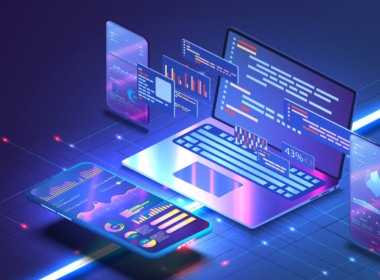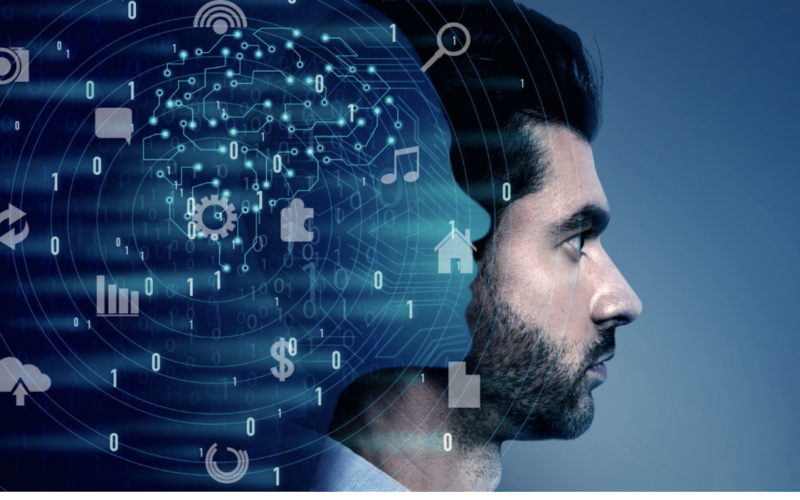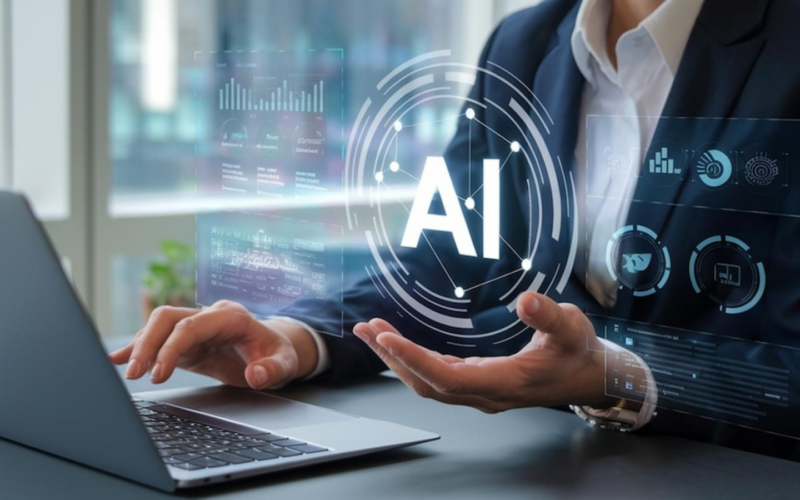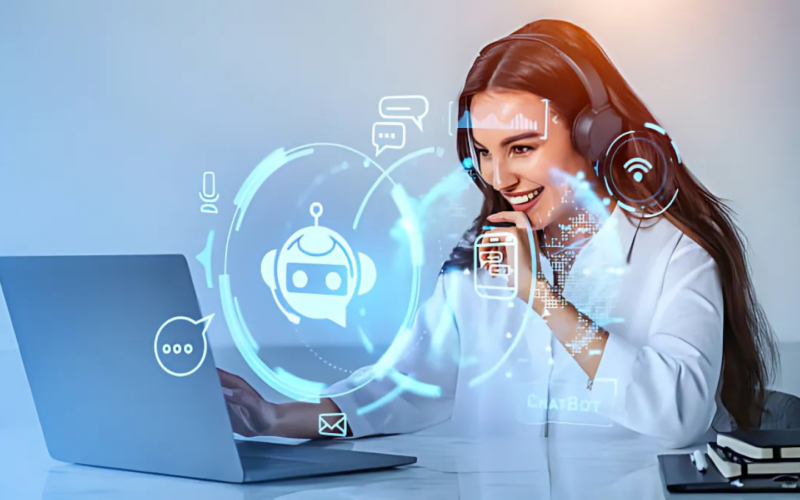As business requirements change over time, the need for smarter, more efficient decision-making grows. For SMEs like yours, this shift is crucial.
Well, traditional AI has already begun transforming industries by automating tasks and processing vast amounts of data. However, we are now witnessing the rise of something even more powerful: augmented intelligence. It goes a step further to support and enhance human decision-making by providing valuable insights and recommendations.
Moreover, this shift is not just theoretical. The global augmented intelligence market is projected to grow to over USD 225.02 billion by 2034, with a CAGR of 25.5%. This rapid growth indicates that augmented intelligence has already begun to arrive.
In this blog, we’ll explore how this shift from traditional AI to augmented intelligence can transform your business, and what you need to know to stay ahead in this fascinating era of human-AI collaboration.
Key Takeaways
- The global augmented intelligence market is projected to reach USD 225 billion by 2034, highlighting its potential to drive business growth.
- Augmented intelligence combines AI’s data-processing capabilities with human intuition, thereby enhancing decision-making across various industries, including healthcare, finance, and retail.
- Augmented intelligence combines machine learning, natural language processing, and real-time data analytics to deliver actionable insights and enhance human capabilities in various business applications.
- Key principles for AI-human collaboration include transparency, ethical development, and practical AI adoption tailored to real business challenges.
- Emerging technologies, such as blockchain, edge computing, and 5G, are amplifying AI’s ability to work seamlessly with human capabilities.
What is Augmented Intelligence?
Augmented intelligence refers to the collaborative synergy between humans and machines, where AI enhances and complements human skills. Unlike traditional AI, which often operates in a rigid, data-driven framework, augmented intelligence combines machine efficiency with human intuition.
It integrates advanced technologies, including machine learning algorithms, artificial neural networks, anomaly detection, and predictive analytics, to process large volumes of data. This way, it provides actionable insights that help humans make better, faster decisions, while human oversight ensures accountability and adherence to ethical considerations.
Fundamentally, augmented intelligence is based on three principles:
- Human-centric approach: AI supports human decision-making, rather than replacing it.
- Collaboration over automation: AI and humans work together for better results.
- Data-driven insights: Machines analyze complex data, enabling human decision-makers to make informed decisions.
In practice, augmented intelligence is transforming industries like healthcare. For instance, AI tools analyze medical records and provide predictive analytics; however, doctors still rely on their expertise to make final decisions, ensuring that treatment plans are tailored to each patient’s specific needs.
Also Read: AI vs Human Intelligence: Differences and Similarities Explained
As augmented intelligence continues to evolve, its impact is being felt across various industries, reshaping how businesses operate and make decisions. Let’s find out how.
The Impact of Augmented Intelligence Across Industries
Augmented intelligence is transforming industries by combining AI with human expertise to create more innovative, more efficient solutions. Furthermore, when paired with augmented reality (AR), it improves user experiences by providing real-time data and insights in sectors such as healthcare, manufacturing, and retail. Here’s how.
- Healthcare: AI-powered systems are transforming the way diseases are diagnosed and treated. By analyzing medical records and predicting risks, augmented intelligence enhances decision-making, improving diagnostic accuracy and treatment plans.
Examples:
- AI systems can identify cancer cells, and when combined with human expertise, error rates drop significantly from 7.5% to 0.5% in some cases.
- AR-assisted surgeries provide real-time AI insights directly in a surgeon’s field of view, improving precision during operations.
- Finance: Augmented intelligence provides a deeper understanding of market trends. By utilizing predictive analytics, financial analysts can anticipate stock fluctuations and automate trading. However, human expertise ensures that broader economic factors are taken into account before making final decisions.
- Manufacturing: AR-driven systems provide AI-powered recommendations to workers, optimizing maintenance procedures and improving operational efficiency.
- Retail: AI analyzes customer behavior and traffic, helping businesses optimize store layouts, product placement, and even personalize shopping experiences through AI-driven chatbots.
- Political Think Tanks: Augmented intelligence can predict voter behavior, targeting undecided voters and optimizing campaigns based on real-time data.
- Mobile Gaming: AI predicts player behavior, adjusting in-game experiences to optimize engagement and retention without human intervention.
Also Read: AI-Augmented Development: Transforming Software Engineering
Why It Matters to SMEs:
- Faster Decision-Making: Augmented intelligence accelerates decision-making by analyzing large datasets and delivering actionable insights. This is especially valuable for small businesses seeking to remain competitive without overwhelming resources.
- Increased Operational Efficiency: AI helps streamline processes, reduce errors, and improve precision. For SMEs in sectors such as healthcare or finance, this means faster service and improved outcomes.
- Customer Insights: Augmented intelligence enables SMEs to gain a deeper understanding of customer behavior. For instance, AI can predict shopping patterns, enhancing product placement and targeting, ultimately boosting sales.
Also Read: Key Trends and Innovations in Augmented Reality
Now, let’s take a closer look at how this powerful technology drives these transformations.
How Does Augmented Intelligence Work?
Augmented intelligence combines artificial intelligence technologies with human input to enhance decision-making and improve business outcomes. It utilizes the following technologies to enhance human capabilities.
Core Technologies Behind Augmented Intelligence:
- Machine Learning: Systems learn from data to identify patterns and make independent decisions, improving over time.
Example: A financial analytics tool that learns from market data to predict stock trends and assist analysts in making data-driven investment decisions.
- Natural Language Processing (NLP): Enables machines to understand and interpret human language, making interactions more natural.
Example: AI chatbots that interpret customer inquiries and provide instant, personalized responses, enhancing customer service without human intervention.
- Spatial Navigation: Artificial neural networks replicate the brain’s function, allowing AI to process complex spatial information.
Example: Autonomous warehouse robots navigate through aisles, identifying inventory locations and optimizing product retrieval in real-time.
- Logical Reasoning: AI uses logical techniques to draw conclusions and predictions based on data.
Example: A fraud detection system in banking that uses AI to analyze transaction patterns and identify suspicious activities, helping banks reduce financial risk.
- Pattern Recognition: Identifies patterns within data, spotting regularities that the human eye may miss.
Example: AI-powered marketing tools analyze customer purchase history to predict future buying behavior. This allows businesses to tailor promotions.
- Machine Vision: Allows computers to “see” and perform automatic analysis and inspections.
Example: Manufacturing inspection systems that use AI to automatically detect product defects on assembly lines, ensuring higher product quality and minimizing manual inspection.
- Sensory Augmentation: Enhances human perception through AI-driven technologies that simulate or augment sensory inputs, such as vision, hearing, and touch.
Example: In healthcare, AI-powered wearable devices enhance doctors’ ability to monitor patients’ vitals, providing real-time data for improved treatment decisions.
Five Core Functions of Augmented Intelligence:
- Comprehend: The system receives data, processes it, and extracts meaningful insights.
Example: AI analyzes a patient’s medical history, laboratory results, and imaging data to assist doctors in diagnosing conditions such as cancer.
- Analyze: New data is continuously interpreted and compared with existing data, revealing new patterns.
Example: AI detects early signs of disease progression in patients with chronic conditions by analyzing their most recent health data and comparing it to past trends.
- Evaluate: The AI processes new information, offering actionable results or insights that inform decision-making.
Example: Based on patient records and real-time health metrics, AI may suggest adjustments to medication or therapy, enabling doctors to improve patient care.
- Learn: Human input helps refine the AI system’s output, making it more accurate and efficient over time.
Example: Doctors provide feedback on AI-driven diagnostic suggestions, helping the system enhance its predictive accuracy and decision-making for future cases.
- Assure: AI or blockchain ensures compliance, security, and risk management to protect and maintain data integrity.
Example: Blockchain technology integrated with AI systems in hospitals ensures that patient records are securely stored and meet regulatory standards such as HIPAA.
Want to enhance decision-making with real-time, immersive insights?
Codewave specializes in developing Augmented Reality (AR) solutions that work seamlessly with augmented intelligence. By integrating real-time data, AR enables your team to make faster, data-driven decisions, thereby improving efficiency and collaboration across various industries.
Book a call to explore how our Extended reality development services can boost your AI-powered decision-making and enhance human capabilities.
While augmented intelligence offers immense potential, its implementation comes with its own set of challenges. Next, you’ll explore some of the key obstacles businesses face when adopting this technology.
Challenges in Implementing Augmented Intelligence
As augmented intelligence integrates into business operations, addressing key challenges like data security, bias, and resistance is crucial for success. By overcoming the following hurdles, you can unlock the full potential of AI to enhance human capabilities and drive more intelligent decision-making.
1. Security Risks: With augmented intelligence systems relying heavily on data, the risk of cyber-attacks and data manipulation grows. Ensuring strong security measures and compliance is crucial to protecting sensitive information.
Why It Matters for SMEs: Data breaches can damage an SME’s reputation. Prioritize strong data security to mitigate these risks.
2. Bias in AI Models: AI models trained on biased datasets can produce unfair outcomes. Removing bias is essential to ensure AI decisions are equitable.
Example: In recruitment, AI tools used by SMEs to screen resumes may unintentionally favor candidates from specific backgrounds if trained on biased hiring data.
Pro Tip: Train AI models on diverse datasets to avoid bias and ensure fair outcomes.
3. Ethical AI and Governance: AI systems must be transparent and accountable. Businesses should prioritize fairness, privacy, and regulatory compliance in their AI strategies to ensure a responsible approach to AI implementation.
Did You Know? Collaborations with researchers like those at Stanford’s AI Index and the Organisation for Economic Co-operation and Development (OECD) can help develop ethical frameworks for AI.
4. Resistance to Adoption: Many organizations resist AI adoption due to fear of change. Overcoming this requires education and showcasing AI’s role in complementing, not replacing, existing systems.
Why It Matters for SMEs: Resistance to AI can limit growth. Engage and educate employees early to build trust and ensure a smooth adoption process.
Pro Tip: Consider phased AI implementations to minimize disruption and ensure smooth integration with current systems.
While addressing these challenges is important, the potential of AI augmentation to enhance human capabilities is what truly shapes the future. Let’s explore more.
How AI Augmentation of Human Capabilities Shapes the Future
Augmented intelligence is more than just a leap forward in AI. It represents the future of human progress. Rather than viewing AI as a replacement for human workers, businesses should focus on creating models that combine the strengths of both AI and human capabilities.
This shift from “AI versus humans” to “AI plus humans” is essential to unlocking the true potential of AI. To effectively capitalize on the power of AI-human collaboration, it’s crucial to understand the key principles.
Key Principles for Effective AI-Human Collaboration
- Explainability and User Control: AI should assist users, not make decisions on their behalf. Clear, transparent decision-making builds trust and promotes adoption.
- Ethical AI Development: Strong governance ensures AI systems are fair, secure, and accountable.
- Pragmatic AI Adoption: AI should be implemented to solve real business challenges, with clear goals and measurable outcomes.
Example: An SME can use AI for inventory management, aiming to reduce waste and improve stock levels, and track results regularly.
Potential Advancements in AI-Human Collaboration
As AI continues to evolve, advancements in AI-human collaboration will unlock even greater potential. Here’s how:
- Real-Time Collaborative Systems: AI-powered platforms will allow employees to collaborate with machines in real-time, improving decision-making and problem-solving capabilities.
Example: In a customer support setting, AI chatbots can analyze live customer queries and suggest responses or actions to human agents, enabling faster and more efficient resolution of issues.
- Enhanced Emotional Intelligence: Future AI systems could interpret emotional cues, facilitating more effective communication and support in fields such as healthcare, customer service, and education.
Example: In healthcare, AI can detect signs of distress in patients’ voices, prompting nurses to provide immediate care. In customer service, AI can recognize frustration in a customer’s tone, enabling agents to tailor their responses for a more empathetic interaction.
- Personalized Learning and Development: AI can tailor learning experiences to individual preferences, helping employees at all levels quickly adapt to new tools and technologies.
Example: An AI-driven platform can analyze an employee’s strengths and weaknesses, then suggest targeted modules or tutorials to help them master new topics faster.
Emerging Technologies and Their Impact on AI Augmentation of Human Capabilities
New technologies are enhancing how augmented intelligence complements human abilities across various sectors. Here’s how:
- Blockchain and AI: The integration of blockchain with AI ensures secure and transparent data handling, which is crucial for industries such as healthcare and finance, where sensitive information is involved.
Example: AI can track patient data, while blockchain ensures it’s tamper-proof and accessible only to authorized personnel, enabling safer and more efficient medical decisions.
- Edge Computing: By processing data closer to its source, edge computing enables AI systems to deliver real-time insights, crucial for applications that require immediate action.
Example: In manufacturing, AI-powered edge devices can detect equipment malfunctions and trigger instant repairs, reducing downtime and increasing productivity.
- 5G and AI: The expansion of 5G networks accelerates AI data processing, enabling real-time AI-driven insights across sectors.
- Example: In autonomous vehicles, AI can instantly analyze surrounding conditions and make decisions on the spot, ensuring safer and more efficient driving experiences.
Having a reliable partner in AI development becomes crucial. With the right expertise, you can ensure the seamless integration of AI into your operations, maximizing human capabilities within your organization.
Transforming Human-AI Collaboration with Codewave’s AI/ML Development Expertise
As businesses look to harness the full potential of augmented intelligence, Codewave stands out as the ideal partner. We seamlessly integrate AI and human capabilities to drive innovation, streamline decision-making, and create tailored AI/ML solutions that enhance efficiency and elevate customer experiences.
Here’s how we make it happen:
- AI-Powered Decision Support: We build custom AI solutions that enhance decision-making by integrating predictive analytics, real-time insights, and automation into business workflows. For example, in healthcare, our AI models analyze patient data to predict health risks, enabling the implementation of proactive interventions and personalized treatment.
Also Read: Understanding the AI Development Process
- Conversational AI and Chatbots: We provide AI-powered chatbots that offer 24/7 customer support, automating routine queries and providing real-time recommendations to human agents. In retail, AI chatbots handle product inquiries and order tracking, enhancing customer satisfaction.
- Natural Language Processing for Human-Centered Insights: Our NLP solutions turn unstructured text data into actionable insights. In the finance sector, this enables businesses to quickly analyze customer feedback, assess sentiments, and automate data categorization, improving services and decision-making.
- Personalized User Experiences: We build systems that bank on AI to deliver real-time, customized recommendations, increasing customer engagement across various industries. In e-commerce, for example, our AI engines suggest products based on past purchasing behavior, improving the shopping experience and driving higher conversion rates.
- Automated Machine Learning (AutoML): For businesses looking to implement machine learning without the complexity, our AutoML solutions simplify the model-building process. These models are continuously optimized, ensuring high performance while prioritizing data security and driving meaningful results.
- Self-Improving Systems: Our self-learning AI systems constantly optimize performance by analyzing data and adapting over time. This ensures that your business systems become smarter and more efficient.
Struggling to unlock the full potential of AI? Our AI/ML solutions can help you enhance human capabilities, simplify decision-making, and drive innovation.
Go through our portfolio to find out how we’ve helped businesses like yours.
Book a discovery call to learn how our custom AI/ML development services can optimize the synergy between AI and human expertise, enabling your team to make more informed decisions and boost productivity.
FAQs
Question 1: Why can augmented intelligence be considered the next growth driver of the US economy?
Augmented intelligence is projected to drive U.S. economic growth, with the market expected to reach $69 billion by 2034, growing at a CAGR of 25.73%. Investments in AI infrastructure are boosting decision-making, operational efficiency, and innovation across industries.
Question 2: What is the difference between AI and augmented intelligence?
Traditional AI automates tasks independently, whereas augmented intelligence enhances human decision-making by providing data-driven insights and recommendations, ensuring human oversight and accountability.
Question 3: How are augmented intelligence and augmented reality related?
Augmented intelligence analyzes data and provides insights, while augmented reality portrays digital information onto the real world. Together, they enhance experiences, such as in healthcare, where AI analyzes patient data while AR helps surgeons visualize critical information during surgery, improving precision.
Question 4: What is the role of augmented intelligence in big data?
Augmented intelligence processes and analyzes large datasets to extract actionable insights, helping businesses make data-driven decisions. For example, in retail, AI analyzes customer purchasing behavior from big data to optimize inventory management and personalize marketing strategies, boosting sales and operational efficiency.
Question 5. How does augmented intelligence contribute to supply chain optimization?
Augmented intelligence optimizes supply chains by analyzing data to forecast demand and manage inventory. AI systems can predict the optimal stock levels, reducing overstocking and stockouts, and thereby improving overall supply chain efficiency.
Codewave is a UX first design thinking & digital transformation services company, designing & engineering innovative mobile apps, cloud, & edge solutions.







